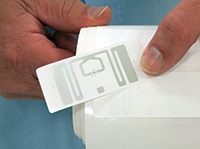What if a single scan of a box of blood products could record the details of every item inside, without the chance of human error?
If an upcoming trial at the Blood Service is successful, in the next few years, customers may begin to see the efficiency, accuracy and cost-saving benefits that come from radio-frequency identification (RFID) tagging.
As with many things that seemed futuristic a few years ago, like smart watches and virtual reality, RFID tags seem almost too good to be true.
Originally first used to track livestock, RFID tags work by using electromagnetic fields to transfer data stored in tiny chips attached to or embedded in a product. Unlike barcodes, the RFID tags don’t need to be in line-of-sight of a scanner to be recorded and more than one tag can be scanned at a time. The tags can also hold more information than a simple barcode, and that information can be changed, updated or locked at any time without being manually handled at all.
In the last few years, blood services worldwide have conducted numerous proof-of-concepts to monitor and track inventory levels in their respective supply chains. Given the benefits of RFID, the Blood Service has begun a 12-week trial at its Melbourne Processing Centre (MPC) to simulate the receipt, freezing, storage and release of plasma sent to CSL for fractionation. Nigel Edwards, Supply Chain Solutions Project Manager, is overseeing the trial.
“An RFID antennae can read all the plasma product tags in the box simultaneously, so staff will no longer have to pick up and scan each product or manually add labels.
“When you’re working with extremely temperature-sensitive products that need to be stored below -30°C, reducing the amount of manual handling should translate to big reductions in overall processing time. The reduction in manual handling also means there will be fewer breakages, leading to more usable plasma for fractionation.”
The faster processing possible with RFID tags should improve inventory management, provide better work health and safety, speed up stocktakes, provide more efficient product recall and release, and allow real-time work-in-progress status updates. Not having to scan every unit will likely also provide benefits during the boxing process at the Blood Service, as well as being beneficial to processes at CSL.
If the trial is successful, the next step would be for the Blood Service to work with government, stakeholders and customers on what the future of RFID in Australia might look like—and where RFID could provide more accuracy and efficiency in the journey of blood from donor to patient.
Photo: A tag of the type being used in the trial.

